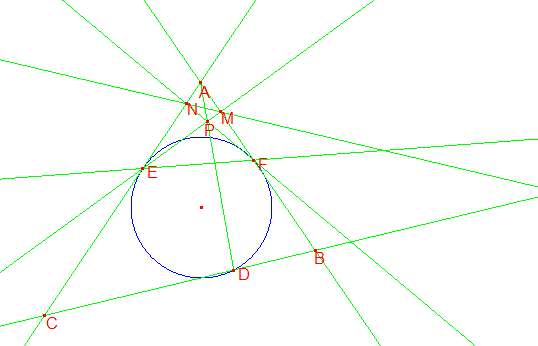Mock USAMO by probability1.01 dropped problems
Problem 1
Let ![]() be a fixed positive integer, and let
be a fixed positive integer, and let ![]() be distinct positive integers. We define
be distinct positive integers. We define ![]() . Prove that there are no distinct positive integers
. Prove that there are no distinct positive integers ![]() for which
for which ![]() is a geometric sequence.
is a geometric sequence.
Reason: The result is somewhat interesting, but no clever or surprising steps are used to solve the problem. Solution
Problem 2
In triangle ![]() ,
, ![]() , let the incircle touch
, let the incircle touch ![]() ,
, ![]() , and
, and ![]() at
at ![]() ,
, ![]() , and
, and ![]() respectively. Let
respectively. Let ![]() be a point on
be a point on ![]() on the opposite
side of
on the opposite
side of ![]() from
from ![]() . If
. If ![]() and
and ![]() meet at
meet at ![]() , and
, and ![]() and
and ![]() meet
at
meet
at ![]() , prove that
, prove that ![]() ,
, ![]() , and
, and ![]() concur.
concur.
Reason: The whole incircle business seemed rather artificial. Besides, it wasn't that difficult.
Problem 3
In triangle ![]() , let
, let ![]() be an interior point. Suppose the circumcircles of
be an interior point. Suppose the circumcircles of ![]() and
and ![]() intersect
intersect ![]() again at
again at ![]() and
and ![]() respectively. Prove that
respectively. Prove that ![]() iff
iff ![]() .
.
Reason: This is really easy with inversion. It's also quite hard without ideas from inversion (try to find a way!). Too bad, it was a pretty nice problem otherwise.
Problem 4
Let ![]() be a cyclic quadrilateral. Prove that
be a cyclic quadrilateral. Prove that ![]()
Reason: This problem was interesting but too simple.
Problem 5
Let a sequence ![]() be defined by
be defined by ![]() and
and ![]() . Prove that all numbers in the sequence are integers.
. Prove that all numbers in the sequence are integers.
Reason: This was actually a pretty good problem, but it was vying for the number 1 or number 4 spot with lots of other problems. Plus, bubala made this one.
Problem 6
In the game of Laser Gun, two players move along the ![]() -axis, and a mirror lies along the segment connecting
-axis, and a mirror lies along the segment connecting ![]() and
and ![]() . A number of opaque computer-controlled tiles of width 1 unit can slide back and forth along the mirror. Each player tries to shoot a laser at himself by reflecting it off of the mirror, thus scoring a point. The computer moves its opaque tiles to try to block the shots. If the players each move at twice the speed of each tile, then what is the minimum number of tiles needed to ensure that neither player can ever score a point?
. A number of opaque computer-controlled tiles of width 1 unit can slide back and forth along the mirror. Each player tries to shoot a laser at himself by reflecting it off of the mirror, thus scoring a point. The computer moves its opaque tiles to try to block the shots. If the players each move at twice the speed of each tile, then what is the minimum number of tiles needed to ensure that neither player can ever score a point?
Reason: The wording is way too confusing, and the whole shooting yourself thing didn’t do Laser Gun justice. However, if you do actually understand this problem, it's rather interesting.










